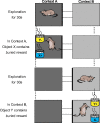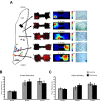Ventral hippocampal neurons are shaped by experience to represent behaviorally relevant contexts
- PMID: 23637197
- PMCID: PMC3667351
- DOI: 10.1523/JNEUROSCI.5458-12.2013
Ventral hippocampal neurons are shaped by experience to represent behaviorally relevant contexts
Abstract
Memories can be recalled at different levels of resolution, from a detailed rendition of specific events within a single experience to a broad generalization across multiple related experiences. Here we provide evidence that neural representations reflecting the specificity or generality of memories are differentially represented along the dorsoventral axis of the CA3 area of the rat hippocampus. In dorsal CA3, neurons rapidly associate the identity of events with specific locations whereas, in more ventrally located CA3 regions, neurons gradually accumulate information across extended training to form representations that generalize across related events within a spatial context and distinguish events across contexts.
Figures








References
Publication types
MeSH terms
Substances
Grants and funding
LinkOut - more resources
Full Text Sources
Other Literature Sources
Miscellaneous
